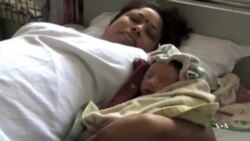A United Nations-led partnership to accelerate improvements in health care has saved the lives of almost 2.4 million poor women and children since 2010 and continues to make gains, a new progress report says.
In the nearly five years since the launch of Every Woman Every Child, the program has created momentum that could halt preventable deaths "within a generation," Secretary-General Ban Ki-moon said at a United Nations event Tuesday to mark the release of “Saving Lives, Protecting Futures."
Ban started EWEC to speed progress toward international health Millennium Development Goals, or MDGs. He said he'd been inspired to do so after witnessing "needless suffering" in his travels.
Women and children in 49 target countries are living healthier lives, thanks to measures such as better prenatal care and more widespread childhood vaccination and oral rehydration for diarrhea.
Before the report's release, EWEC senior manager Nana Kuo told VOA that efforts to improve family planning, adolescent health and increase life-saving medicine and health services also contributed to the gains.
Since 2010, the combined efforts have aided 120,000 women, 650,000 newborns and 1.6 million children younger than 5, Kuo said. "This accounts for 40 percent of those lives that could have been saved if the health MDGs were met by the end of 2015."
The encouraging results come from historic levels of political and financial support. The effort has more than 300 partners: Rich and poor countries, private foundations, businesses, members of civil society and the U.N. itself have pledged $60 billion, out of which two-thirds already has been disbursed.
Kuo said this has turned into the fastest-growing global public partnership in history.
Most maternal and child deaths can be prevented with affordable, simple solutions, providing hope that the health goals are attainable, she said.
"Today, we are seeing the fastest reduction in maternal and child mortality, with almost 6.4 million children [fewer] dying every year and maternal mortality being reduced by half since 1990," Kuo said.
More progress needed
But more can be done, the report said – a point echoed by an official with the March of Dimes.
In recent years, "attention to the unique health benefits of disease prevention to adolescents, mothers, newborns and children has lagged," said Christopher Howson, an epidemiologist and vice president of global programs for the New York-based nonprofit, which promotes infant and maternal health.
While he praised efforts by Ban and the EWEC partnership, Howson called for "renewed attention" to mothers.
"Moms who are healthy not just at the time of childbirth but throughout pregnancy are essential to ensuring a safe, healthy birth and newborn," he said in comments emailed to VOA. "And because every mother should go into her pregnancy as healthy as possible, the March of Dimes calls also for acceleration of programs to improve the health of young women and adolescents before they become pregnant."
Howson said preventive health programs also should "address the critical health needs of middle-income countries and lower-mortality low-income countries to a greater degree than they have in the past."
Those needs include preventing death and disability related to preterm birth and birth defects, as well as noncommunicable diseases such as diabetes and cardiovascular disease.








